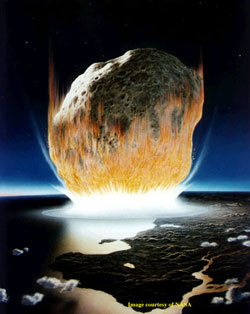Single strike killed the dinosaurs says new study
Single strike killed the dinosaurs says new study
mongabay.com
December 1, 2006
A new study argues that “one and only one” meteorite impact — not multiple impacts as some scientists have suggested — caused the extinction of dinosaurs some 65 million years ago.
“The samples we found strongly support the single impact hypothesis,” said Ken MacLeod, associate professor of geological sciences at the University of Missouri-Columbia and lead investigator of the study. “Our samples come from very complete, expanded sections without deposits related to large, direct effects of the impact – for example, landslides – that can shuffle the record, so we can resolve the sequence of events well. What we see is a unique layer composed of impact-related material precisely at the level of the disappearance of many species of marine plankton that were contemporaries of the youngest dinosaurs. We do not find any sedimentological or geochemical evidence for additional impacts above or below this level, as proposed in multiple impact scenarios.”
Examining sediment recovered from the Demerara Rise in the Atlantic Ocean northeast of South America, about 4,500 km (2,800 miles) from the impact site on the Yucatan Peninsula, MacLeod and his colleagues said that their samples “provide an unusually clear picture of the events at the time of the mass extinction.”
 This image was created by Don Davis and is provided courtesy of NASA. |
“With our samples, there just aren’t many complications to confuse interpretation. You could say that you’re looking at textbook quality samples, and the textbook could be used for an introductory class,” MacLeod said. “It’s remarkable the degree to which our samples follow predictions given a mass extinction caused by a single impact. Sedimentological and paleontological complexities are minor, the right aged-material is present, and there is no support for multiple impacts or other stresses leading up to or following the deposition of material from the impact.”
The researches say that the impact likely caused massive earthquakes and tsunamis, while dust from the impact would entered the atmosphere, blocking sunlight and causing immediate cooling which would have killed plant life and eliminated important food sources for animals like dinosaurs. The impact may have also triggered widespread forest fires and acid rain.
The study is published in the ‘in press’ section of the online version of the Geological Society of America Bulletin.
The Cretaceous-Tertiary extinction (K-T extinction event) occurred about 65.5 million years ago. Evidence suggesting the role of extraterrestrial impact in the extinction, which killed more than half the world’s species, was first published in 1980 by a team of researchers led by Nobel-prize-winning physicist Luis Alvarez. Other scientists have suggested that extensive volcanic activity may have contributed to the exinction.
This is a modified news release from the University of Missouri-Columbia.